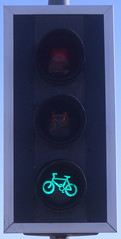 Image by dullhunk via Flickr
Image by dullhunk via Flickr
In general, I think that such rules are a good idea and apparently cyclist and legislatures agree, as such rules have been enacted in many states to date.
While bicycles are treated as vehicles, and have the same rights and responsibilities, they aren't the same as their larger cousins. Bicycles are smaller and inherently don't protect their operators in the same way that an motor vehicle does. Factors such as lack of shocks, narrow tires at high pressure, some modicum of balance required for operation cause bicycles to be operated slightly differently than autos. Obstacles that larger vehicles can navigate with little risk to the vehicle occupants become more threatening to bicycle riders.
As a cyclist, situations arise where I need more than a few inches of space, which is all some drivers and cyclist consider necessary for my safety. Consider the cases of accidentally riding in the door zone and needing to react to an opening door. If there is a vehicle immediately to your left and no room to change path around the door, a pothole or broken glass in the path of the cyclist requiring a deviation in path to safely navigate. Even with enough control and warning to stop, the alternative is that the cyclist may be forced to interact with the hazard and go down on the road. Never mind the discomfort of having a 1 ton or heavier vehicle pass at such a close distance.
Why a law; because if its a law, its much more likely to come up during drivers education and makes for a potential question on drivers exams. It serves to reinforce that bicycles have a right to use the road.
A concern voiced by some cyclists in opposition to such laws is that by drawing attention to cyclists as a special class of vehicles brings the danger of more onerous laws restricting their use. Yes, there is a danger of backlash at singling bicycle riders out in a statute that could lead to unwanted consequences. There probably isn't any more danger than already exists because of motorists observing bicycles operated counter to existing laws, particularly stop sign and traffic signal stops, which seem to gather the most attention from motorists, though certainly "salmoning" also causes great agitation.
One way I see to mitigate this is to clarify the existing passing statute with respect to ALL vehicles, not just bicycles. My thought is to reword RI Laws 31-15-4, 31-15-6, 31-15-11 to a wording that means something like the following:
On a multi lane road, the overtaking vehicle must change lanes to pass. On single lane roads, a safe passing distance of at least 3 feet should be maintained while overtaking until safely past the overtaken vehicle. If a safe distance cannot be obtained, the overtaking vehicle must slow and wait until conditions permit safely overtaking the slower vehicle.Wording such as this would also benefit carriages, scooters and farm vehicles. It would also serve to clarify the poor choice of wording in the H5074 of "slowing to 10 to 20 miles per hour below the posted speed limit". Nobly intended under the assumption that a bicycle is likely to be traveling less than 25 miles per hour, but too wishy-washy to be meaningful.
An issue I have with the proposed law is the inclusion of a new term, instead of using the term defined previously in the section on overtaking vehicles. The existing law uses the phrase "shall pass to the left at a safe distance and shall not again drive to the right side of the roadway until safely clear of the overtaken vehicle." The text of H5074 reads "leaving a reasonable and prudent distance between the vehicle and the bicycle. A three foot (3′) passing distance between the motor vehicle and passing bicycle shall be deemed to be reasonable and prudent." Why can't the proposed law reuse and define "safe distance" instead of creating "reasonable and prudent" and then defining it? There is also the problem that defining reasonable and prudent in H5074 could cause unwanted effects to the use of the phrase reasonable and prudent in 31-15-12 on following distances.
Do I think such a law is enforceable? No, not really. Again, I think that it serves as an educational tool. The danger with rewording it the way I've suggested is of course that drivers who never ride bikes are still not going to think of bikes as vehicles and will continue their auto-centric methods of operation.
While it is the responsibility of all vehicle operators to be in control of their vehicle at all times, situations do occur where minimizing the risk and damage done is the best that can be achieved. By defining for all vehicle operators what is considered to be a safe margin, perhaps the number of auto on cyclist injuries and fatalities can be reduced.
Here is the text of the proposed law, H5074:
31-15-18. Keeping a three foot passing distance when passing a bicycle. —
(a) A person operating a motor vehicle, when approaching a bicyclist, shall insure the safety and protection of the bicyclist by leaving a reasonable and prudent distance between the vehicle and the bicycle. A three foot (3′) passing distance between the motor vehicle and passing bicycle shall be deemed to be reasonable and prudent. When impossible to achieve the three foot (3′) passing distance, then the vehicle shall reduce its speed to ten (10) to twenty (20) miles per hour below the posted speed limit.
![Reblog this post [with Zemanta]](http://img.zemanta.com/reblog_e.png?x-id=63853795-d8c0-4114-ad9a-a092c34dc04e)



0 comments:
Post a Comment